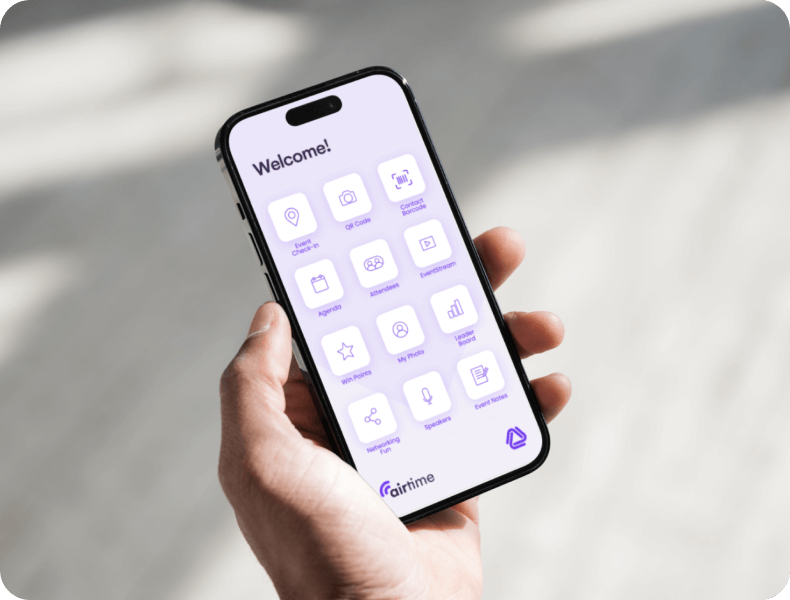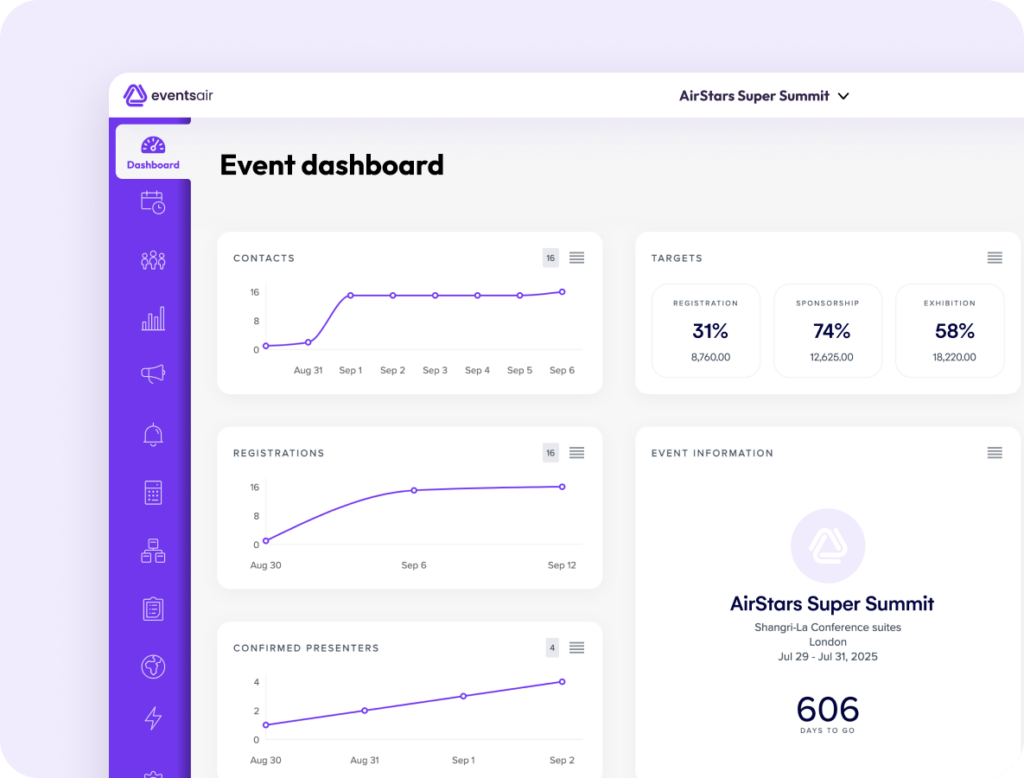The Ultimate Virtual Events Checklist: Expert Tips for Seamless Planning

Hosting a successful virtual event demands precise planning and execution. A detailed checklist ensures you don’t miss essential steps, like setting clear goals, choosing the right platform, and engaging your audience effectively.
Virtual events thrive on seamless technology, captivating content, and smooth logistics. Using a strategic checklist streamlines the process, ensuring all aspects, from pre-event marketing to post-event analytics, are covered for maximum impact.
As an expert in digital event management solutions, we equip organizers with tools and actionable insights to create outstanding virtual experiences. Therefore, this EventsAir guide breaks down the key elements for planning virtual events efficiently.
What is a virtual events checklist?
A virtual events checklist is a strategic tool that organizes every aspect of planning and executing virtual events. It ensures nothing is overlooked, covering technology setup, content creation, audience engagement, and post-event evaluation for maximum efficiency and impact.
This tool isn’t just a planning aid—it’s a roadmap for success. By using it, organizers can align resources, streamline workflows, and deliver engaging, high-quality virtual experiences.
Why is a virtual events checklist important?
A virtual events checklist is essential for ensuring a seamless, well-organized event. It provides clarity, minimizes errors, and enhances overall effectiveness. Here are the top reasons why it’s a must-have:
- Comprehensive planning: Ensures no critical details, like technical setups or attendee communications, are overlooked.
- Efficient time management: Helps prioritize tasks and allocate resources effectively to meet deadlines.
- Improved attendee experience: Details smooth execution, from registration to event day activations, to post-event engagement tools.
- Risk mitigation: Anticipates potential issues, like platform failures, allowing for proactive solutions.
- Measurable outcomes: Structures post-event analysis to assess success and improve future events.
Top 5 items in an effective virtual events checklist
1. Define event objectives and audience
The foundation of any successful virtual event starts with clear objectives and a well-defined audience. Without these, the event can lose focus, resulting in wasted resources and suboptimal outcomes. Here’s how to approach this critical first step:
- Set clear, measurable goals: Establish what success looks like for your event. Are you aiming to increase brand awareness, generate leads, or provide valuable educational content? Ensure your objectives are measurable so you can track progress and adjust accordingly. The SMART framework is perfect here.
- Understand your audience: Identify who will attend your event and tailor content to their needs. Use attendee personas to map out their expectations, challenges, and interests. This helps ensure your content resonates and engages.
- Align content and engagement strategies with goals: Once your objectives and audience are clear, decide on content formats that best support them. For example, if your goal is to educate, then webinars, workshops, and live Q&A sessions may be ideal.
2. Select and configure your event platform
Choosing the right platform is crucial for a seamless virtual event experience. The platform acts as the central hub for all attendee interactions, from registration to content delivery.
Here’s how to ensure your platform choice aligns with your event’s objectives:
- Evaluate features based on event goals: Different events require different functionalities. For example, a large-scale conference needs robust networking tools, while a training session may prioritize content delivery features. Ensure the platform supports your goals by offering the right tools—like live streaming, audience engagement, or breakout sessions. Have a diverse set of needs for different events? Ensure you can invest in a flexible solution.
- Prioritize customization and branding: Your chosen platform should be flexible enough to reflect your brand. Look for customization options that allow for tailored registration forms, branded event apps, and personalized attendee experiences. EventsAir’s customizable event apps help ensure a consistent brand experience across all touchpoints for both attendees and organizers.
- Ensure scalability and stability: Choose a platform that can handle the scale of your event without compromising performance. EventsAir’s platform is designed to scale seamlessly, ensuring that no matter how large your attendee base is, the experience remains smooth and reliable.

3. Identify and integrate your tech stack
The success of a virtual event hinges on the seamless integration of various technologies that support your event’s objectives. Building a solid tech stack ensures that all aspects of the event—registration, payments, marketing, speaker management, lead capture, attendee engagement, and analytics—work together harmoniously.
Here’s how to identify and integrate the right technologies:
- Assess core requirements: Identify your event’s essential needs. If networking is key, integrate virtual meeting rooms and networking lounges. For content-heavy events, look for platforms with strong content management and streaming capabilities. EventsAir integrates multiple features specific to virtual events, including registration, presentations, content delivery, and live engagement tools, ensuring a seamless user experience.
- Ensure integration with existing systems: Your tech stack should connect with other systems you use, like CRM software, marketing tools, and payment gateways. EventsAir’s open API and pre-built integrations allow smooth data flow between your event platform and external tools, reducing the risk of manual errors and inefficiencies.
- Evaluate analytics and reporting tools: Choose tools that provide real-time insights into attendee behavior, session popularity, and engagement levels. EventsAir’s built-in analytics suite provides robust reporting capabilities, allowing organizers to adjust content and strategies as needed.
4. Involve the stakeholders
Involving key stakeholders early in the event planning process ensures alignment and accountability throughout. This step is crucial for ensuring that everyone has a clear understanding of their roles and responsibilities, as well as the event’s overall objectives.
Here’s how to effectively involve stakeholders:
- Identify key stakeholders early: Stakeholders can include sponsors, speakers, exhibitors, and internal teams. Make sure you involve them in the planning process to align their contributions with your event goals.
- Define roles and responsibilities: Clearly define each stakeholder’s role, from content creation to technical support. Establish timelines and ensure all parties are aware of their deadlines. This prevents miscommunication and delays.
- Regular communication and updates: Keep stakeholders informed with regular updates and check-ins. Use collaboration tools to keep everyone on the same page. EventsAir’s project management features allow you to track progress and assign tasks efficiently.
- Leverage stakeholder feedback: Encourage stakeholders to provide input on event design, platform selection, and engagement strategies. Their insights can help identify potential issues early and improve event quality.
5. Engage attendees and collect feedback
Engaging attendees and collecting feedback are essential for the success of your virtual event. Active participation boosts the overall experience, while feedback provides insights to improve future events. Here’s how to maximize engagement and gather valuable data:
- Foster interaction through engagement tools: Utilize interactive tools like live polls, Q&A, and gamification to keep attendees involved. EventsAir’s platform offers a range of customizable engagement features to drive participation and create a dynamic event experience.
- Create networking opportunities: Facilitate attendee networking through breakout rooms and 1:1 meetings. Matching attendees based on shared interests often enhances the value of networking during your event.
- Collect real-time feedback: Use instant surveys, live polls, or feedback forms during the event to gauge attendee satisfaction. With EventsAir’s analytics and reporting features, you can capture event insights in real-time, ensuring you get precise, updated data to adjust content or strategies as needed.
- Post-event surveys and analysis: After the event, send follow-up surveys to capture in-depth feedback. Analyze the responses to identify strengths and areas for improvement, ensuring that future events are even more successful.

Take advantage of our OnAIR Platform to host successful virtual events
EventsAir’s OnAIR platform empowers organizations to host successful virtual events by offering a comprehensive suite of features, such as:
- Virtual sessions: Live, pre-recorded, or live-streamed sessions for diverse engagement.
- On-demand access: Pre-recorded content available on demand.
- Meeting hub & networking groups: One-on-one and group networking opportunities.
The Academy of International Business (AIB) is one of the numerous organizers that have leveraged OnAIR to transition their annual conference online. The AIB used OnAIR to host over 50 sessions, resulting in a record-breaking 1,255 delegates, proving the platform’s ability to replicate high-touch, in-person experiences virtually.
Discover seamless virtual event management today
Planning and executing a successful virtual event requires meticulous attention to detail. From technical rehearsals to interactive content strategies, robust cybersecurity, and time zone optimization, these steps ensure a seamless experience for attendees. With EventsAir, you can streamline this process effortlessly.
EventsAir is a comprehensive event management platform designed to handle every aspect of virtual events. From pre-event planning to real-time engagement and post-event analytics, EventsAir equips you with the tools needed to deliver impactful virtual experiences with ease.
Book a demo today to see how you can create exceptional virtual events with EventsAir.



